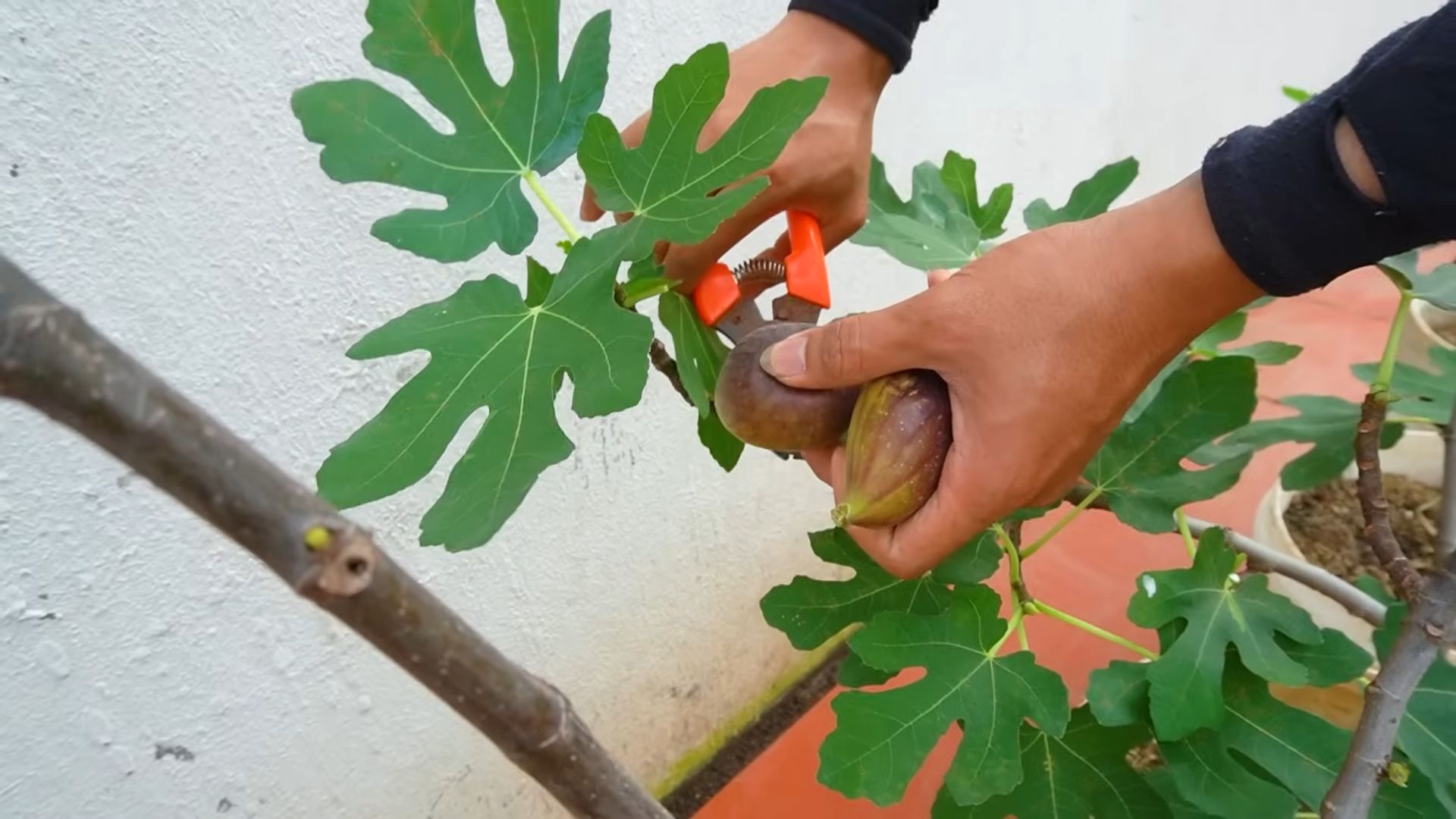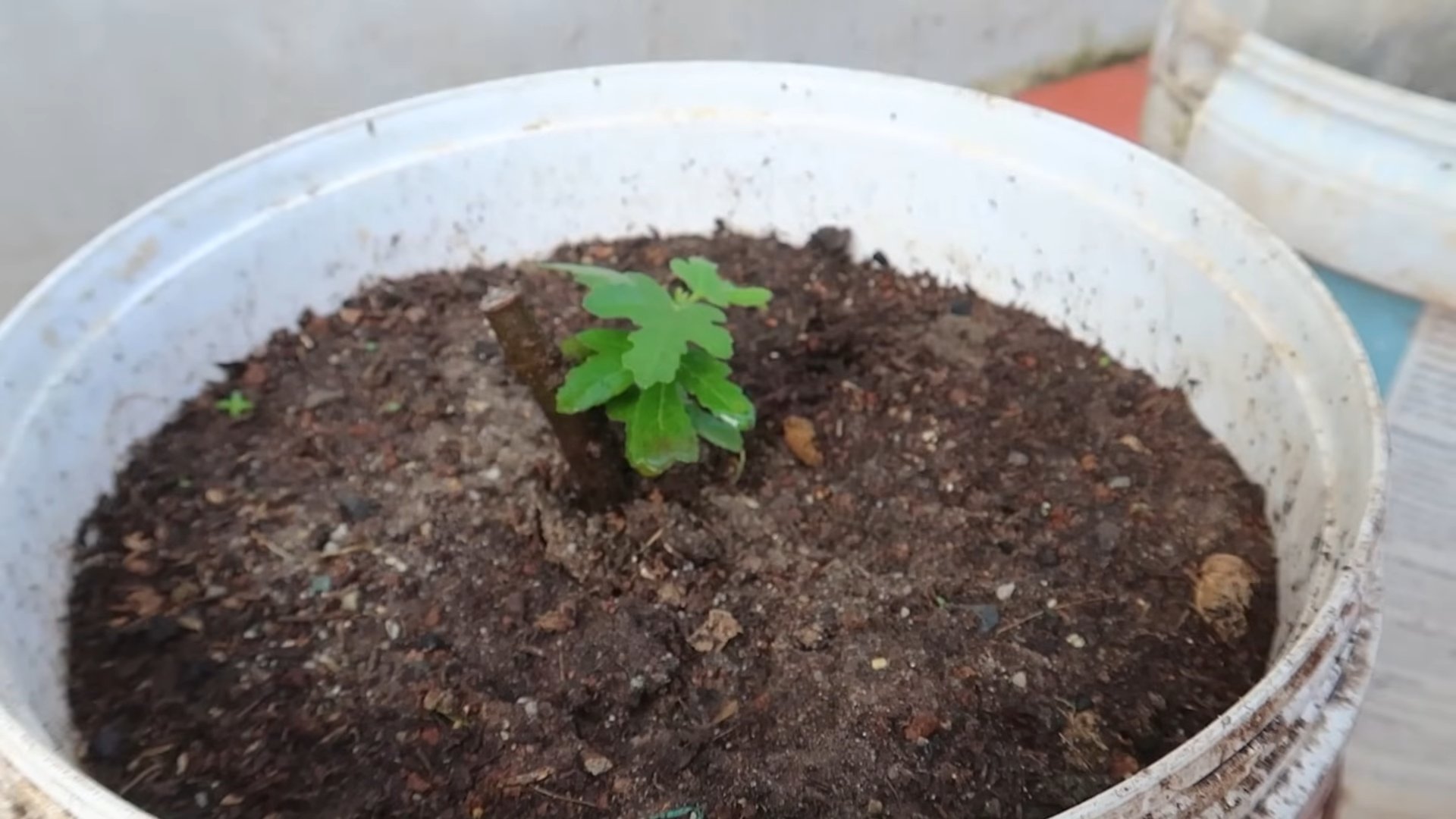Grow Figs at Home Quickly? Absolutely! Imagine plucking sweet, juicy figs straight from your own backyard – a taste of the Mediterranean right at your fingertips. For centuries, figs have been cherished, not just for their delicious flavor, but also for their rich symbolism, representing prosperity and peace in many cultures. From ancient Greece, where they were a staple food, to modern-day gardens, figs have a timeless appeal.
But let’s be honest, the thought of cultivating these luscious fruits can seem daunting. Many gardeners believe that growing figs requires a green thumb and a whole lot of luck. That’s where these DIY tricks and hacks come in! I’m here to tell you that you don’t need to be an expert to grow figs at home quickly and successfully.
This article is your ultimate guide to demystifying the process. We’ll explore simple, effective techniques that will have you harvesting your own bountiful fig crop in no time. Whether you’re dealing with limited space, a challenging climate, or simply want to accelerate the fruiting process, I’ve got you covered. Get ready to unlock the secrets to growing these delightful fruits and enjoy the satisfaction of a thriving fig tree right in your own backyard!

Grow Figs at Home Quickly: A DIY Guide
Okay, so you want to grow figs at home, and you want them *now*? I get it! Figs are delicious, and the idea of plucking them fresh from your own tree is incredibly appealing. While fig trees aren’t exactly overnight sensations, there are definitely ways to speed up the process and get you enjoying those sweet, juicy fruits sooner rather than later. This guide will walk you through everything you need to know, from choosing the right variety to providing the perfect growing conditions. Let’s get started!
Choosing the Right Fig Variety for Speed and Success
The first, and arguably most important, step is selecting a fig variety that’s known for its early and abundant fruiting. Not all fig trees are created equal! Some take years to mature and produce, while others are much more precocious. Here’s what to look for:
- Consider your climate: This is crucial! Some fig varieties are more cold-hardy than others. If you live in a colder region, you’ll need a variety that can withstand freezing temperatures. Brown Turkey, Chicago Hardy, and Celeste are good options for colder climates. If you live in a warmer climate, you have more choices, including Black Mission, Kadota, and LSU Gold.
- Look for “self-pollinating” or “common” figs: These varieties don’t require pollination from a fig wasp to produce fruit. This is a huge advantage, as fig wasps aren’t present in all areas. Most of the popular fig varieties fall into this category.
- Choose a variety known for early fruiting: Some varieties naturally produce fruit earlier in the season than others. Brown Turkey, Celeste, and Improved Celeste are known for their relatively early harvests.
- Consider container growing: If you’re limited on space or live in a colder climate, container growing is a great option. This allows you to move the tree indoors during the winter. Dwarf varieties like Little Miss Figgy are perfect for containers.
Preparing for Planting: Location, Location, Location!
Figs thrive in sunny locations with well-drained soil. Here’s how to prepare your planting site:
- Sunlight: Fig trees need at least 6-8 hours of direct sunlight per day. Choose a location that gets plenty of sun throughout the day.
- Soil: Fig trees prefer well-drained soil with a slightly acidic to neutral pH (around 6.0-7.0). If your soil is heavy clay, amend it with compost, sand, and other organic matter to improve drainage.
- Spacing: If you’re planting multiple fig trees, space them at least 15-20 feet apart to allow for adequate growth. For container-grown figs, choose a pot that’s at least 15-20 gallons in size.
- Protection from wind: Fig trees can be susceptible to wind damage, especially when they’re young. Choose a location that’s sheltered from strong winds, or provide some sort of windbreak.
Step-by-Step Planting Guide
Now for the fun part – planting your fig tree! Here’s a detailed guide to ensure a successful planting:
1. Dig the hole: Dig a hole that’s twice as wide as the root ball and just as deep. This will give the roots plenty of room to spread out.
2. Amend the soil: Mix the soil you removed from the hole with compost, aged manure, or other organic matter. This will improve drainage and provide nutrients for the tree.
3. Remove the tree from the container: Gently remove the fig tree from its container. If the roots are circling the pot, gently loosen them with your fingers.
4. Place the tree in the hole: Place the tree in the hole, making sure the top of the root ball is level with the surrounding soil.
5. Backfill the hole: Backfill the hole with the amended soil, gently tamping it down as you go.
6. Water thoroughly: Water the tree thoroughly after planting to help settle the soil and hydrate the roots.
7. Mulch: Apply a layer of mulch around the base of the tree to help retain moisture, suppress weeds, and regulate soil temperature. Use organic mulch such as wood chips, straw, or shredded bark. Keep the mulch a few inches away from the trunk to prevent rot.
8. Stake (optional): If the tree is young and spindly, you may want to stake it to provide support. Use soft ties to attach the tree to the stake, and remove the stake after a year or two once the tree is established.
Watering and Fertilizing for Rapid Growth
Proper watering and fertilization are essential for promoting rapid growth and fruit production.
- Watering: Water your fig tree deeply and regularly, especially during the first year after planting. Aim to keep the soil consistently moist, but not waterlogged. Water more frequently during hot, dry weather. Once the tree is established, you can reduce watering frequency, but still water deeply during dry spells. A good rule of thumb is to water when the top inch of soil feels dry to the touch.
- Fertilizing: Fig trees benefit from regular fertilization, especially during the growing season. Use a balanced fertilizer (such as 10-10-10) in the spring, and then switch to a fertilizer that’s higher in phosphorus and potassium (such as 5-10-10) in the summer to promote fruit production. Follow the instructions on the fertilizer label for application rates. You can also amend the soil with compost or aged manure to provide a slow-release source of nutrients. Avoid over-fertilizing, as this can lead to excessive vegetative growth at the expense of fruit production.
Pruning for Shape and Fruit Production
Pruning is an important part of fig tree care. It helps to shape the tree, remove dead or diseased wood, and promote fruit production.
- When to prune: The best time to prune fig trees is in late winter or early spring, before new growth begins.
- How to prune: Start by removing any dead, diseased, or crossing branches. Then, prune to shape the tree and open up the canopy to sunlight. Fig trees produce fruit on new growth, so avoid pruning too heavily, as this can reduce fruit production. For young trees, focus on developing a strong framework of branches. For mature trees, prune to maintain the desired size and shape.
- Pruning container-grown figs: Container-grown figs may need more frequent pruning to control their size. You can prune them more heavily than in-ground trees, as they have less room to grow.
Protecting Your Fig Tree from Pests and Diseases
Fig trees are generally relatively pest and disease-resistant, but they can be susceptible to certain problems.
- Common pests: Common fig pests include aphids, spider mites, and scale. These pests can be controlled with insecticidal soap or horticultural oil.
- Common diseases: Common fig diseases include fig rust, leaf spot, and root rot. These diseases can be prevented by providing good air circulation, avoiding overwatering, and applying a fungicide if necessary.
- Protecting from birds: Birds love figs! To protect your fruit from birds, you can cover the tree with netting or use bird-repellent devices.
- Protecting from squirrels: Squirrels are another common fig pest. You can deter squirrels by using squirrel-repellent devices or by wrapping the trunk of the tree with metal flashing.
Encouraging Early Fruiting: Tricks of the Trade
Okay, here’s where we get into some specific techniques to really speed things up and encourage early fruiting:
1. Root Pruning: This might sound scary, but it can actually encourage fruit production. In late winter or early spring, use a sharp spade to cut into the soil around the drip line of the tree (the area directly beneath the outer edge of the branches). Make several cuts, going down about 12-18 inches. This will slightly restrict the root system, which can signal the tree to focus on reproduction (fruiting) rather than vegetative growth.
2. Girdling: This is another technique that involves slightly injuring the tree to encourage fruiting. In late spring, use a sharp knife to carefully remove a narrow strip of bark (about 1/4 inch wide) around the circumference of a branch. Be careful not to cut too deep, as this can damage the tree. This will disrupt the flow of nutrients to the branch, which can encourage it to produce fruit. Only girdle a few branches at a time, and don’t girdle the main trunk.
3. Pinching: Pinching is a simple technique that involves removing the tips of new shoots. This encourages the tree to branch out and produce more fruiting wood. Pinch off the top inch or two of new shoots in the spring and summer.
4. Container Growing Advantages: As mentioned before, container growing offers some advantages

Conclusion
So, there you have it! Growing figs at home quickly isn’t just a pipe dream; it’s an achievable reality with a little know-how and the right approach. We’ve explored the key elements that contribute to rapid fig growth, from selecting the right variety and providing optimal sunlight to mastering watering techniques and understanding the importance of fertilization. This isn’t just about having a fig tree; it’s about enjoying the satisfaction of nurturing a plant and reaping the delicious rewards sooner than you ever thought possible.
The beauty of this DIY approach is its adaptability. Feel free to experiment with different container sizes to find what works best for your space. If you live in a colder climate, consider using a wheeled pot to easily move your fig tree indoors during the winter months. You can also explore different training methods, such as espaliering, to maximize fruit production in a limited area. For those with larger gardens, planting directly in the ground, while requiring more space, can lead to even more robust growth and higher yields over time.
Why is this a must-try? Because fresh, homegrown figs are simply unparalleled in flavor. The figs you find in stores often pale in comparison to the sweetness and richness of a fig picked straight from your own tree. Plus, growing your own figs is a sustainable and rewarding way to connect with nature and enjoy the fruits (literally!) of your labor. It’s a project that offers both immediate gratification and long-term benefits.
Don’t be intimidated by the prospect of growing your own figs. With the tips and techniques outlined here, you’re well-equipped to embark on this exciting journey. Remember to be patient, observant, and willing to adapt your approach as needed. Every fig tree is unique, and learning its individual needs is part of the fun.
We wholeheartedly encourage you to give this DIY trick a try. Start small, be consistent, and watch your fig tree flourish. And most importantly, don’t forget to share your experience with us! We’d love to hear about your successes, challenges, and any variations you’ve discovered along the way. Post pictures of your thriving fig trees, share your favorite fig recipes, and let’s create a community of fig-growing enthusiasts. Your insights could inspire others to take the plunge and experience the joy of growing their own delicious figs at home quickly. Let us know what variety of fig you chose and how quickly you saw results!
Frequently Asked Questions (FAQ)
Q: What is the best variety of fig to grow for quick results?
A: While several fig varieties are known for their relatively quick fruiting, the ‘Brown Turkey’ fig is often recommended for beginners. It’s known for its hardiness, adaptability, and ability to produce fruit within the first year or two of planting. ‘Chicago Hardy’ is another excellent choice, especially for colder climates, as it’s incredibly resilient and can withstand harsh winters. ‘Celeste’ is a smaller fig with a sweet flavor that also fruits relatively early. Ultimately, the best variety for you will depend on your climate and personal preferences. Research varieties that are well-suited to your region and consider factors like fruit size, flavor, and cold hardiness.
Q: How much sunlight does my fig tree need to grow quickly?
A: Figs thrive in full sun, meaning they need at least 6-8 hours of direct sunlight per day. The more sunlight they receive, the faster they will grow and the more fruit they will produce. If you’re growing your fig tree in a container, position it in the sunniest spot in your yard or on your patio. If you’re planting it in the ground, choose a location that receives ample sunlight throughout the day. Insufficient sunlight can lead to slow growth, reduced fruit production, and leggy, weak branches.
Q: How often should I water my fig tree?
A: Watering frequency depends on several factors, including the size of your tree, the type of soil, and the weather conditions. Generally, you should water your fig tree deeply whenever the top inch or two of soil feels dry to the touch. During hot, dry periods, you may need to water more frequently. Avoid overwatering, as this can lead to root rot. Ensure that your pot has good drainage to prevent water from pooling at the bottom. A good rule of thumb is to water thoroughly until water drains out of the drainage holes. During the dormant season (winter), reduce watering significantly.
Q: What kind of fertilizer should I use for my fig tree?
A: Figs benefit from regular fertilization, especially during the growing season. A balanced fertilizer with a ratio of 10-10-10 or 8-8-8 is a good starting point. Apply the fertilizer according to the manufacturer’s instructions, typically in the spring and again in mid-summer. You can also supplement with organic fertilizers like compost or aged manure. Avoid over-fertilizing, as this can damage the tree. Look for fertilizers specifically formulated for fruit trees for optimal results.
Q: How do I protect my fig tree from pests and diseases?
A: Figs are generally relatively pest-resistant, but they can be susceptible to certain problems, such as fig rust, spider mites, and scale. Regularly inspect your tree for signs of pests or diseases. If you notice any problems, take action promptly. For minor infestations, you can often control pests with insecticidal soap or neem oil. For more serious problems, you may need to use a stronger pesticide or fungicide. Proper watering, fertilization, and pruning can also help to prevent pests and diseases. Good air circulation around the tree is also important.
Q: How do I prune my fig tree to encourage faster growth and fruiting?
A: Pruning is essential for maintaining the health and productivity of your fig tree. The best time to prune is during the dormant season (late winter or early spring). Remove any dead, damaged, or crossing branches. You can also prune to shape the tree and encourage new growth. Figs produce fruit on both new and old wood, so avoid excessive pruning. Focus on thinning out the canopy to allow for better air circulation and sunlight penetration. Research the specific pruning requirements for your fig variety for best results.
Q: Can I grow a fig tree indoors?
A: Yes, you can grow a fig tree indoors, but it requires careful attention to its needs. Choose a dwarf variety that is well-suited to container growing. Provide plenty of bright, indirect light. Supplement with artificial light if necessary. Maintain consistent watering and fertilization. Ensure good air circulation. Be aware that indoor fig trees may not produce as much fruit as those grown outdoors.
Q: How long does it take for a fig tree to produce fruit?
A: The time it takes for a fig tree to produce fruit varies depending on the variety, growing conditions, and age of the tree. Some varieties, like ‘Brown Turkey,’ can produce fruit within the first year or two of planting. Others may take longer. Providing optimal sunlight, watering, and fertilization will help to speed up the process. Be patient and persistent, and you’ll eventually be rewarded with delicious, homegrown figs.
Q: What do I do if my figs are dropping before they ripen?
A: Premature fig drop can be caused by several factors, including stress, insufficient watering, lack of pollination (for some varieties), or pest infestations. Ensure that your tree is receiving adequate water and sunlight. Check for signs of pests or diseases. If the problem persists, consult with a local gardening expert for advice. Some fig varieties require pollination by a specific wasp, so research your variety’s needs.
Q: How do I know when my figs are ripe?
A: Ripe figs will be slightly soft to the touch and will have a drooping neck. The skin may also crack slightly. The color of the fig will depend on the variety, but it will typically deepen as it ripens. The best way to tell if a fig is ripe is to taste it! Ripe figs will be sweet and juicy. Gently pluck the fig from the tree; it should come off easily when ripe.





Leave a Comment